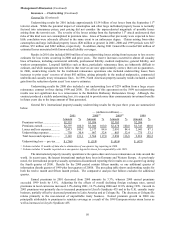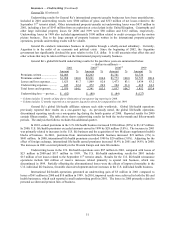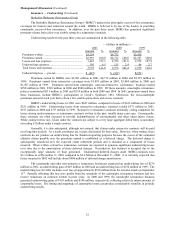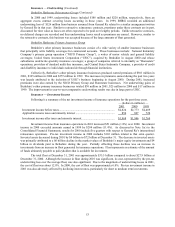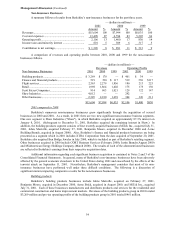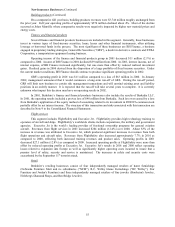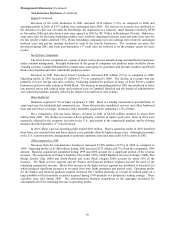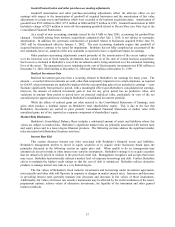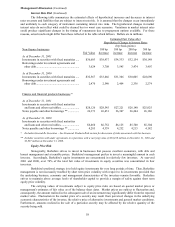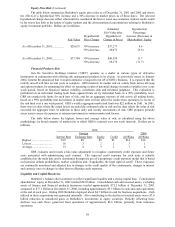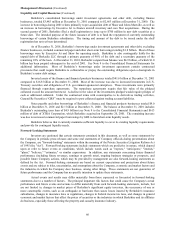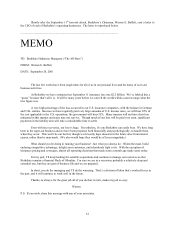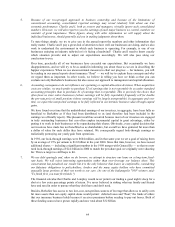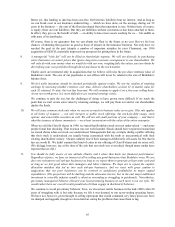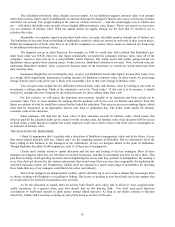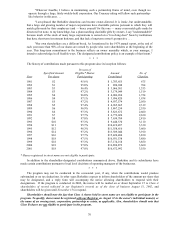Berkshire Hathaway 2001 Annual Report Download - page 61
Download and view the complete annual report
Please find page 61 of the 2001 Berkshire Hathaway annual report below. You can navigate through the pages in the report by either clicking on the pages listed below, or by using the keyword search tool below to find specific information within the annual report.60
Management's Discussion (Continued)
Liquidity and Capital Resources (Continued)
Berkshire’ s consolidated borrowings under investment agreements and other debt, excluding finance
businesses, totaled $3,485 million at December 31, 2001 compared to $2,663 million at December 31, 2000. The
increase in borrowings during 2001 relates primarily to pre-acquisition debt of Shaw and Johns Manville, as well as
an increase in borrowings by Executive Jet to finance aircraft inventory and core fleet acquisitions. During the
second quarter of 2001, Berkshire filed a shelf registration to issue up to $700 million in new debt securities at a
future date. The intended purpose of the future issuance of debt is to fund the repayment of currently outstanding
borrowings of certain Berkshire subsidiaries. The timing and amount of the debt to be issued under the shelf
registration has not yet been determined.
As of December 31, 2001, Berkshire’ s borrowings under investment agreements and other debt, excluding
finance businesses, included commercial paper and other short-term borrowings totaling $1.8 billion. Most of these
borrowings were by Executive Jet and Shaw for operating needs. Berkshire is also contingently liable for the
unpaid debt of Berkadia LLC through a primary guaranty of 90% of the debt and a secondary guaranty of the
remaining 10% of the loan. At December 31, 2001, Berkadia’ s unpaid loan balance was $4.9 billion, of which $1.0
billion has been prepaid subsequent to the end of 2001. See Note 9 to the Consolidated Financial Statements for
additional information. Most of Berkshire’ s borrowings under investment agreements contain contractual
provisions that could require Berkshire to collateralize or prepay the outstanding obligations upon a downgrade in
Berkshire’ s senior debt ratings.
Invested assets of the finance and financial products businesses totaled $41.6 billion at December 31, 2001
compared to $16.8 billion at December 31, 2000. Most of the increase was due to increased investments in U.S.
Treasury securities and obligations of U.S. government-sponsored enterprises. These investments were primarily
financed through repurchase agreements. The repurchase agreements require that fair value of the pledged
collateral exceed the amount borrowed. A decline in the value of the investments pledged would require pledges of
cash or additional collateral. Under the contractual terms with counterparties to its derivatives trading activities,
General Re Securities (“GRS”) may be required to post collateral against trading account liabilities.
Notes payable and other borrowings of Berkshire’ s finance and financial products businesses totaled $9.0
billion at December 31, 2001 and $2.1 billion at December 31, 2000. The balance at December 31, 2001 includes
Berkadia’ s outstanding term loan of $4.9 billion (see Note 9 to the Consolidated Financial Statements) and $613
million of debt of XTRA Corporation, which Berkshire acquired on September 20, 2001. The remaining increase
was due to increased commercial paper borrowings by GRS to fund short-term liquidity needs.
Berkshire believes that it currently maintains sufficient liquidity to cover its existing liquidity requirements
and provide for contingent liquidity needs.
Forward-Looking Statements
Investors are cautioned that certain statements contained in this document, as well as some statements by
the Company in periodic press releases and some oral statements of Company officials during presentations about
the Company, are "forward-looking" statements within the meaning of the Private Securities Litigation Reform Act
of 1995 (the "Act"). Forward-looking statements include statements which are predictive in nature, which depend
upon or refer to future events or conditions, which include words such as "expects," "anticipates," "intends,"
"plans," "believes," "estimates," or similar expressions. In addition, any statements concerning future financial
performance (including future revenues, earnings or growth rates), ongoing business strategies or prospects, and
possible future Company actions, which may be provided by management are also forward-looking statements as
defined by the Act. Forward-looking statements are based on current expectations and projections about future
events and are subject to risks, uncertainties, and assumptions about the Company, economic and market factors and
the industries in which the Company does business, among other things. These statements are not guaranties of
future performance and the Company has no specific intention to update these statements.
Actual events and results may differ materially from those expressed or forecasted in forward-looking
statements due to a number of factors. The principal important risk factors that could cause the Company's actual
performance and future events and actions to differ materially from such forward-looking statements, include, but
are not limited to, changes in market prices of Berkshire's significant equity investees, the occurrence of one or
more catastrophic events, such as an earthquake or hurricane that causes losses insured by Berkshire's insurance
subsidiaries, changes in insurance laws or regulations, changes in Federal income tax laws, and changes in general
economic and market factors that affect the prices of securities or the industries in which Berkshire and its affiliates
do business, especially those affecting the property and casualty insurance industry.


